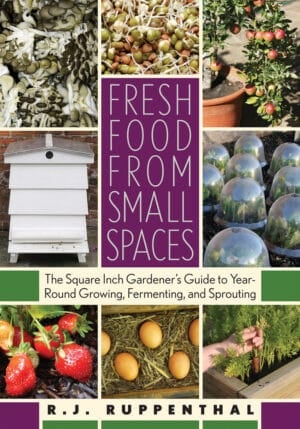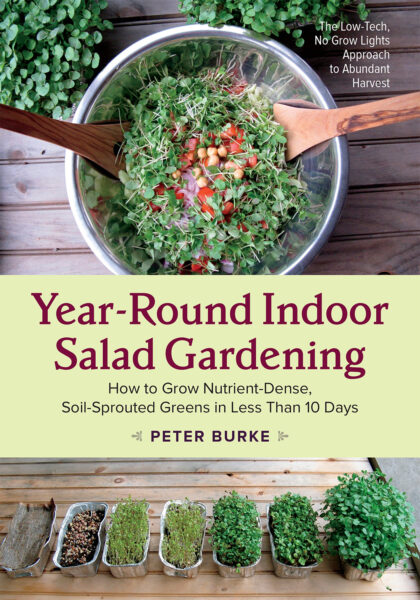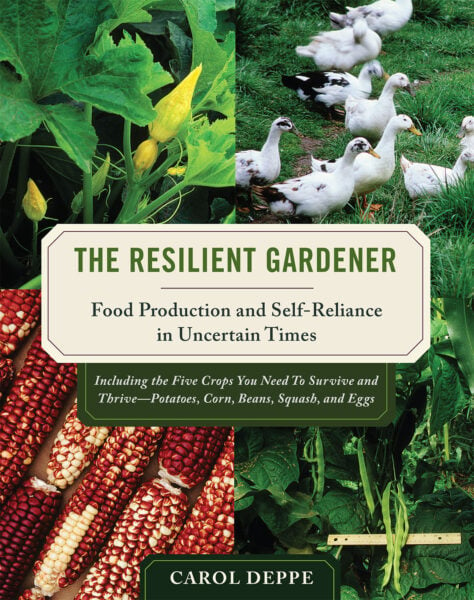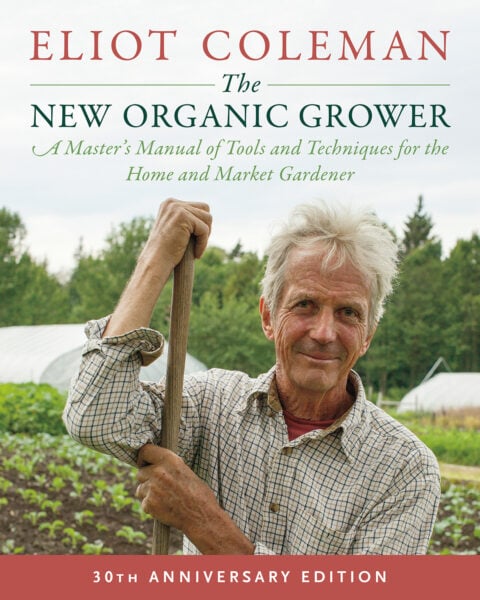Tips for the Square-Inch Gardener: Vertical Gardening
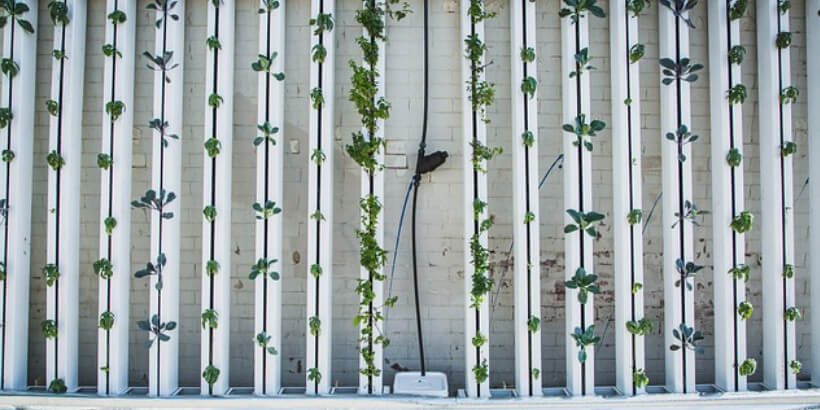
Do you dream of having your own garden but live in a city or an area with not enough space? Try vertical gardening! Take advantage of plants’ willingness to grow toward sunshine ability to grow in unusual places. There are three techniques involved in vertical gardening: terracing, trellising, and tumbling. Each is designed to maximize the limited sunlight and space you have.
The following article was adapted for the web from Fresh Food from Small Spaces by R. J. Ruppenthal. It has been adapted for the web.
Vertical gardening involves utilizing your vertical growing space to make the best use of light resources. It is also an important consideration for city gardeners who may have more vertical than horizontal space available for growing. Vertical gardening is a general strategy that involves some specific techniques—terracing, trellising, and tumbling—to allow plants more access to lighted space.
The first technique is terracing. On a larger agricultural scale, terracing is the practice of building several steps into a sloped hillside. These steps are progressive, with each one higher than the previous step. In many countries, this has been used as a method of farming vertical landscapes and of conserving water in the process. Terraced agriculture was practiced by the Romans, Incas, and other ancient cultures, with the Hanging Gardens of Babylon being a famous urban example. Rice paddies are planted on terraced hillsides throughout much of Southeast Asia, providing some of the most beautiful man-made scenery in the world.

Terraced planting in Italy: using every square inch of a hillside. you can use your available light the same way, either by raising up the back rows of plants or by planting taller and thicker vegetables behind shorter or thinner ones, ensuring each row gets adequate sunlight.
On a smaller urban scale, terracing your plants involves arranging them in steps so that each one gets plenty of light. Many city gardeners have an overhanging roof or a nearby building that blocks the midday sun, although their gardens get a few hours of early or late light. If your best sunlight hours are in the early morning and/or late afternoon, then your sunlight will come mainly from the side. An outer row of plants will get most of this light energy while any inner rows may be completely blocked by these outer plants. By terracing your plants instead, putting the tallest ones in the back and the shorter ones in the front, you can grow a lot more under these conditions.
You can terrace plants in one of two ways. The first way is to arrange your garden so that shorter plants such as greens and carrots are on outer rings or rows (facing your late or early sidelight). Taller plants such as tomatoes, peppers, and legumes should be placed further back in this scheme. If you have enough space for more than two parallel rows, then you can either use multiple rows of shorter plants, or else terrace in three heights.
If you terrace in three heights, be sure to trim or train the middle row of plants anytime they threaten to block out the back row. The second way to terrace plants is to design the garden itself at layered heights. Using raised beds, containers of different height, or cinderblock boosters, you can lay out the garden so that even plants of similar heights will each get that early or late sun.
Trellising is another great vertical gardening technique. Several varieties of vegetables grow particularly well when trellised. Plants with natural vining tendencies include cucumbers, peas, and beans. These plants have limited root systems and a natural inclination to climb skyward, so they can be planted relatively close together and will make very productive use of available planting space. Tomatoes, squash, and small melons also can be trellised and trained upward.
The cucumber is a great example of a plant you can train vertically. From the moment a cucumber has its first few leaves, it begins to unfurl its tentacles, grabbing hold of the nearest support. It may fix itself to a wire rod, fishing line, bamboo pole, wooden fence, metal railing, or neighboring plant’s stem. Using this support, the plant climbs upward and outward, building its vine. In a city garden, you can use any available material to make a trellis for each plant; just keep it less than half an inch in thickness so that the plant can grab hold. A length of fishing line or twine that is tightly wrapped back and forth from a railing or nearby pole is as good as anything else for training cucumbers and peas.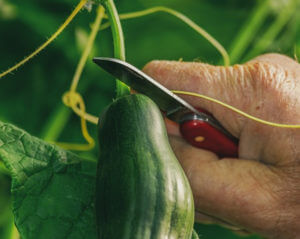
Effective trellising enables you to keep plants off the ground and allows you to raise one plant from every few inches of soil. One additional trick to maximize space with cucumbers is to alternate the trellis back and forth for every other plant, so that they grow upward in a V shape. Plants 1, 3, and 5 are encouraged to climb forward and upward, while plants 2, 4, and 6 are trained backward and upward. Peas and beans can be planted quite closely together, and peas especially are accustomed to being crowded; they will produce well as long as they have enough air circulation to stave off diseases such as mildew.
Tumbling involves growing plants downward from a hanging planter. If you have more airspace than floor space, consider hanging a planter or two from your ceiling, eaves, window ledge, or railing. Strawberries, cherry tomatoes, herbs, and bush beans grow extremely well over the edges of hanging planters, providing you with fresh food that “tumbles” down into your vertical growing space. Although most hanging baskets are designed more for flowers than larger rooting vegetables, you can hang any type of container that can be supported (just remember, wet soil gets quite heavy). Clay pots, buckets, and window boxes all can hang vertically. If you are using a container such as clay that has no holes for hanging, you may want to invest in a hanging basket, or else you can use a few pieces of wire, rope, or twine to create your own supportive cradle for the pot.
A few years ago, a new product appeared on the market called a TopsyTurvy Tomato Planter. The idea was to hang the plant upside down, holding the soil in and then allowing the plant to grow downward and outward toward the light. Although the product was innovative and provided additional support for heavy plants, the basic idea was similar to a hanging grow bag.
To hang a grow bag, you can start with a small bag of soil or purchase an actual grow bag that is made of woven plastic. Several gardening catalogs and Internet sites sell grow bags relatively cheaply, so you can get a dozen or more at once to save on shipping. If you have an extra bag (or partially full bag) of potting soil, tie it up and use some rope or twine to suspend it from a hook or outside rafter where it will get some sun. When the weather is warm enough to plant, wet your soil in the grow bag, cut an “x” in the plastic every few inches, and put in some strawberry seeds or small seedlings.
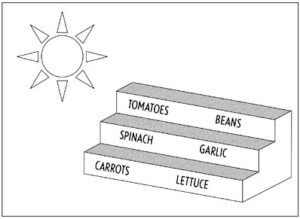 Seedlings may need a little extra support at first, and for this you can use a pipe fitting or some duct tape around the edges. If you hang this over a stairwell or walkway, be sure that it is safely fastened so as not to drop on any passersby. Be sure to keep the bag well watered and use a little liquid fertilizer such as diluted compost tea or kelp extract. It’s not the most beautiful container, but with some patience and good fortune you’ll soon have some cascading plants that produce delicious, juicy strawberries. What could be more beautiful than that?
Seedlings may need a little extra support at first, and for this you can use a pipe fitting or some duct tape around the edges. If you hang this over a stairwell or walkway, be sure that it is safely fastened so as not to drop on any passersby. Be sure to keep the bag well watered and use a little liquid fertilizer such as diluted compost tea or kelp extract. It’s not the most beautiful container, but with some patience and good fortune you’ll soon have some cascading plants that produce delicious, juicy strawberries. What could be more beautiful than that?
Hanging planters of any sort can be a great place for growing cherry tomatoes, strawberries, bush beans, herbs, or even smaller cucumbers.
Vinelike veggies that tumble over the side are especially effective at using vertical space. The key is not to plant anything too big, because hanging planters usually are limited in size. Recommended varieties with a trailing habit include “Cool Breeze” cucumbers, “Patio Temptation” strawberries, “Tumbling Tom” or “Tiny Tim” tomatoes, and any variety of bush bean or edible thyme. There are more varieties developed each year for specific purposes such as this, so do not confine yourself to these suggestions. If any fruit gets heavy enough that it threatens to break off, tie it up with some twine or a piece of cloth. In smaller hanging planters, consider growing some edible flowers, herbs, baby salad greens, or wheatgrass for juicing.
Recommended Reads
Recent Articles
Garlic mustard: while known as “invasive,” this plant can be consumed in its entirety and has great nutritional value. Plus, the garlic-flavor is a perfect addition to any recipe that calls for mustard! The following are excerpts from Beyond the War on Invasive Species by Tao Orion and The Wild Wisdom of Weeds by Katrina…
Read MoreEveryone loves a refreshing, fermented, nutritious drink…even your garden! Take your fermentation skills out of the kitchen and into the garden by brewing fermented plant juice. The following is an excerpt from The Regenerative Grower’s Guide to Garden Amendments by Nigel Palmer. It has been adapted for the web. How to Make Fermented Plant Juice Fermented…
Read MoreOh, honeysuckle…how we love thee. If only there was a way to capture the sweet essence of this plant so we could enjoy it more than just in passing. Luckily, foraging and some preparation can help make that happen! Here’s a springtime recipe that tastes exactly like honeysuckle smells. The following excerpt is from Forage,…
Read MoreWant to see your crops thrive this upcoming growing season? The key is in soil fertility and health. Spend time maintaining your soil’s health to guarantee bigger and better crops come harvest time! The following is an excerpt from No-Till Intensive Vegetable Culture by Bryan O’Hara. It has been adapted for the web. What Is Soil Fertility?…
Read MoreIntroducing…your new favorite brunch dish! This whole broccoli frittata is packed with fresh, wildcrafted flavors that are bound to help you start your day off on the right foot. The following is an excerpt from The Forager Chef’s Book of Flora by Alan Bergo. It has been adapted for the web. RECIPE: Whole Broccoli Frittata…
Read More

